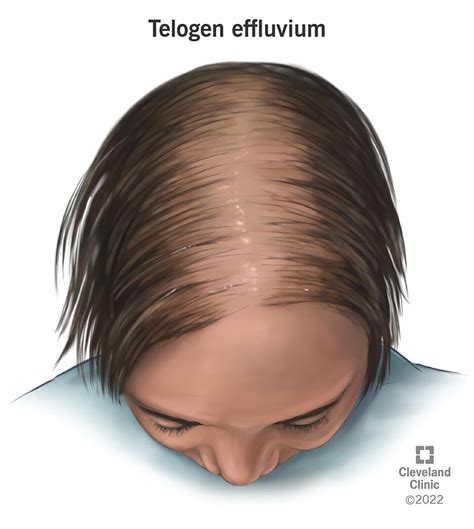Hair loss is a common problem that affects both men and women. While it can occur anywhere on the scalp, it is often most noticeable on the top of the head. There are a number of potential causes of hair loss on top of the head, including genetics, hormonal changes, and medical conditions.

1. Androgenetic Alopecia (Male-Pattern Baldness)
This is the most common cause of hair loss in men. It is caused by a combination of genetic factors and the male hormone DHT. DHT shrinks hair follicles, causing them to produce thinner and shorter hairs over time. Eventually, the hair follicles may stop producing hair altogether.
2. Alopecia Areata
This is an autoimmune condition that causes hair to fall out in small, round patches. It can affect people of all ages, but it is most common in children and young adults. The exact cause of alopecia areata is unknown, but it is thought to be related to a problem with the immune system.
3. Telogen Effluvium
This is a temporary type of hair loss that can be caused by a number of factors, such as stress, illness, or certain medications. Telogen effluvium typically causes hair to thin all over the scalp, but it can also lead to hair loss on top of the head.
4. Thyroid Problems
An underactive thyroid can lead to a number of health problems, including hair loss. When the thyroid gland does not produce enough thyroid hormone, it can cause the hair follicles to become weak and thin.
5. Iron Deficiency
Iron is essential for hair growth. When the body is low on iron, it can lead to hair loss. Iron deficiency is most common in women who are pregnant or breastfeeding, but it can also occur in people who have certain medical conditions, such as anemia.
6. Medications
Some medications can cause hair loss as a side effect. These medications include chemotherapy drugs, blood thinners, and antidepressants.
7. Other Medical Conditions
Certain medical conditions, such as lupus and diabetes, can also lead to hair loss. This is because these conditions can damage the hair follicles or cause the body to produce hormones that can lead to hair loss.
When to See a Doctor
If you are experiencing hair loss on top of your head, it is important to see a doctor to determine the cause. This is especially important if you are losing hair suddenly or in large amounts. Your doctor can perform a physical examination and ask you about your medical history to help determine the cause of your hair loss. They may also order blood tests or other tests to rule out any underlying medical conditions.
Treatment Options
The treatment for hair loss on top of the head depends on the cause. There are a number of different treatments available, including medications, surgery, and lifestyle changes.
Medications
There are a number of medications that can be used to treat hair loss. These medications include minoxidil and finasteride. Minoxidil is a topical medication that is applied to the scalp. It works by stimulating hair growth. Finasteride is an oral medication that is used to treat male-pattern baldness. It works by blocking the production of DHT.
Surgery
Surgery is an option for people who have severe hair loss. There are two main types of hair transplant surgery: follicular unit transplantation (FUT) and follicular unit extraction (FUE). FUT involves removing a strip of scalp from the back of the head and transplanting it to the top of the head. FUE involves removing individual hair follicles from the back of the head and transplanting them to the top of the head.
Lifestyle Changes
There are a number of lifestyle changes that can help to prevent hair loss. These changes include eating a healthy diet, getting enough sleep, and managing stress. Eating a healthy diet that is rich in vitamins and minerals can help to nourish the hair follicles and promote hair growth. Getting enough sleep is also important for hair growth. When the body is sleep-deprived, it produces more of the stress hormone cortisol, which can lead to hair loss. Managing stress is also important for hair growth. Stress can cause the hair follicles to go into a resting phase, which can lead to hair loss.
Tips for Preventing Hair Loss
There are a number of things you can do to help prevent hair loss. These tips include:
- Eat a healthy diet. A diet that is rich in vitamins and minerals can help to nourish the hair follicles and promote hair growth.
- Get enough sleep. When the body is sleep-deprived, it produces more of the stress hormone cortisol, which can lead to hair loss.
- Manage stress. Stress can cause the hair follicles to go into a resting phase, which can lead to hair loss.
- Avoid harsh hair care products. Harsh hair care products can damage the hair follicles and lead to hair loss.
- Protect your hair from the sun. The sun’s UV rays can damage the hair follicles and lead to hair loss.
Conclusion
Hair loss on top of the head is a common problem that can have a number of different causes. While there is no cure for hair loss, there are a number of treatments available that can help to slow down or stop hair loss. If you are experiencing hair loss, it is important to see a doctor to determine the cause and to discuss treatment options.
- Be patient. Hair loss treatment can take time to work. It is important to be patient and to follow your doctor’s instructions.
- Don’t give up. If one treatment doesn’t work, don’t give up. There are a number of different treatments available, and you may need to try a few before you find one that works for you.
- Talk to your doctor. If you have any concerns about hair loss, talk to your doctor. Your doctor can help you determine
